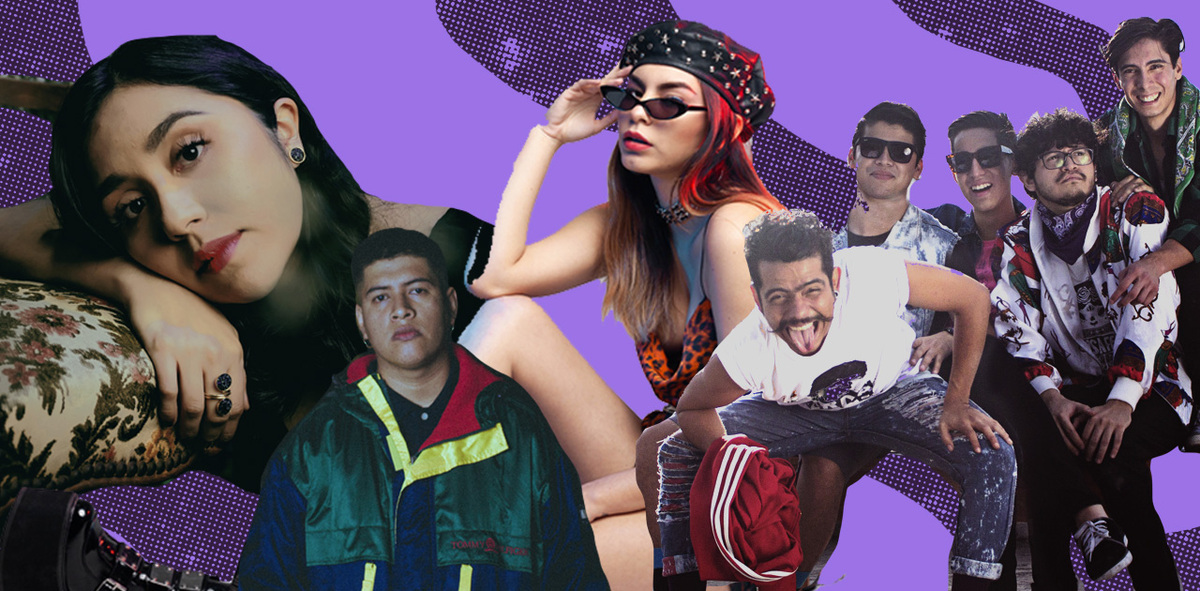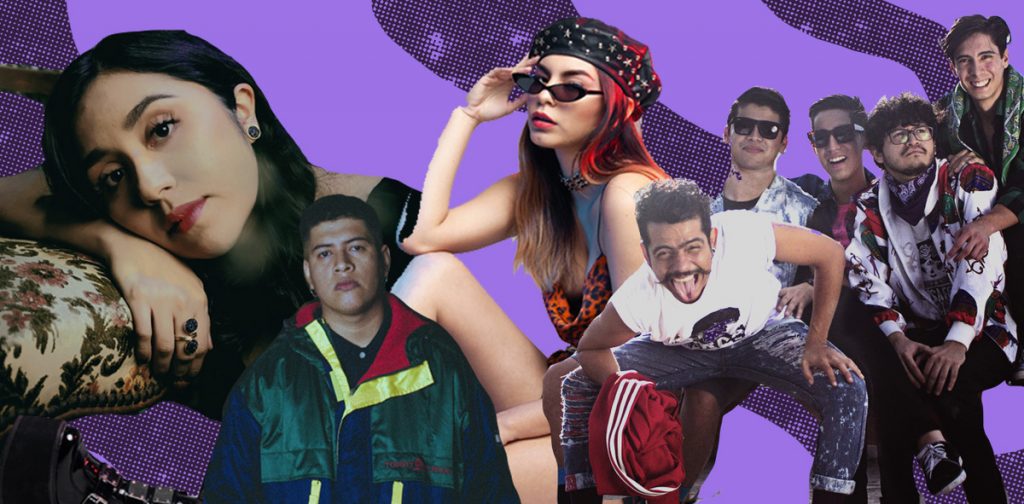Where is Central America? I don’t mean on a map—but in the media. With the rare exception of Costa Rica, which in the past we’ve highlighted as an exciting haven for music, fashion and nightlife, the rest of the region remains a glaring omission from the greater cultural conversation. Take El Salvador for example; The smallest nation in Central America, by square mileage, is also home to breathtaking beaches, verdant landscapes, bomb local cuisine and vibrant movements in music, fine arts and film.
The sound of El Salvador can be described as a melange of influences from powerhouse neighbors like Mexico, Colombia and the Caribbean—manifesting in colorful pockets of rock and reggae throughout the capital city’s urban sprawl and its breathtaking nearby beach towns. Cumbia reigns safely as the country’s sonic lingua franca, a genre where stalwarts like Marito Rivera and Orquesta San Vicente are able to connect with children and their grandparents alike. However, when it comes to the hip underground kids, unspooling a connective musical thread becomes more challenging.
El Salvador’s turbulent political history—which includes nearly a century of dictatorships, civil wars and gang violence—has shaped much of its cultural yield, paving the way for punk and rap as essential outlets for a society in trauma. Ignition (hardcore), Toma el Riesgo (straight edge), Adhesivo (ska) and Los Bastardos (experimental) all doled out brutal catharsis over the past decade, eviscerating injustice, institutional violence and economic inequality over throbbing mosh pits. Rappers like Snif and Oneime have also put their necks on the line for their art, spinning intimate portraits of barrio life that bring hope to a new generation of kids eagerly searching for paths beyond gang membership.
“For a scene to exist there must be some sort of harmony, whether musical, emotional, spiritual or ideological,” says Fran Maravilla, one of El Salvador’s most influential and beloved cultural organizers. Maravilla has been an integral part of the national scene for nearly 13 years as member of bands Polly Class and Manyula Dance Club, booker and event coordinator at the iconic Casa Tomada, and a cornerstone of Central America’s tightly-knit indie network. “There need to be meeting grounds,” he adds, “which is what Beatriz Alcaine tried to build with La Luna. Sons of military officers who let their hair grow after the peace treaties were signed—they would come hang out at La Luna. The kids of left-wing exiles who fled to Mexico would also show up and take theater classes there because it was the most similar environment they could find to what they had experienced in Mexico City.”
A lack of venues is one of the many challenges faced by the Salvadoran underground. La Luna closed in 2012 and recently reopened under new ownership as Buhos Pizza, which is once again among the favorite venues in San Salvador. La Casa Tomada shuttered its doors last year and though it’s expected to re-open elsewhere, an exact date and location have not yet been determined. The city’s French Alliance and Spanish Cultural Center often host one-off events, while La Resi, a popular multimedia space that welcomes visual artists, independent educators and musicians alike, remains a bastion of experimentation and collaboration for all who seek it.
El Salvador’s indie music industry is still in its infancy, and though a strong push for formalizing press and management relationships is being made, spearheaded by organizations like KUI and publications Factum and Bulla, many musicians lack the knowledge or tools to properly market their projects. “Musicians here often think about other musicians when creating, not necessarily of their audience, and that’s one of the hurdles that keeps them from growing,” suggests Maravilla when asked about the scene’s relative stasis.
During a recent visit to San Salvador, I noticed a major generational gap at live shows, where young people seemed largely absent from consecutive rap and alternative showcases. “New musicians are learning about music from their parent’s record collection, not from the bands on the scene,” adds Maravilla, suggesting that parents who lived through the end of the civil war that culminated in the early 90s, as well as the rise of gangs like MS-13 and Barrio 18, are sheltering their kids out of reasonable fear for their safety.
Mass migrations have also affected the Salvadoran scene significantly, perpetuating a cycle of brain drain that has scattered members of bands like Cartas a Felice, Adrenalina and Primal Pulse across the globe. Economic instability and safety are largely cited as the main reasons for departure, and while violent crime has declined during current President Nayib Bukele’s government, remittances made up close to 21% of the national GDP in 2018, indicating migration waves will likely continue.
However, there is still much to discover and revere in the Salvadoran underground. Luciana Fortis’ HUS parties and Consecuencia Fest are laying the groundwork for a rapidly growing local electronic music scene. The Ghetto Witches collective and funk ensemble Las Musas Desconectadas have also emerged as agitating feminist forces in what is still a macho-driven scene, disrupting archaic gatekeeping tactics through brazenly inclusive parties and a proud commitment to activism. And while reggaeton continues to blare from the majority of car windows and busy nightclubs, the genre remains largely unexplored territory for Salvadoran musicians—with some even suggesting it might be the scene’s next big wave.
To guide you through this small but vibrant ecosystem, we’ve put together a list of 11 artists representing the different corners of the Salvadoran underground. Whether you’re looking to dance, mosh or daydream in your room, these Salvadoran artists are ready to dazzle.
1
Zaki
Rap is sonic currency in El Salvador and Zaki is intent on cashing in. Picking up a mic for the first time in 2013, Zaki cut his teeth in freestyle circles commonplace throughout San Salvador, eventually releasing his first album, Trez, in 2017 to much local fanfare. He later relocated to Guatemala City, where he has closely collaborated with rappers like Kontra and Rebeca Lane, and released two more albums, Hara Kiri (2018) and Hellboy (2019). Zaki’s nimble lyricism and polished beats have thrust a well-earned spotlight on the rapper, priming him for the eventual crossover.
2
Cartas a Felice
Cartas a Felice is one of the most beloved Salvadoran indie bands of the past decade, colliding influences from rock, cabaret and cumbia into whimsical, expertly crafted productions with cinematic flair. While their eclectic 2015 debut Mango Swing made the band a household name, their forthcoming sophomore album promises a major sonic leap. Production duties are being helmed by Mexico’s Daniel Me Estás Matando and moody singles like “El Diablo” and “El Alacrán,” and the layered experimentation of “El Zope” all point to a long-anticipated star turn.
3
Gabriela Triste
A quirky E-girl turned unlikely viral pop star, Gabriela Triste is undoubtedly one of the most unique talents in El Salvador. Starting out as a YouTube parodist, her wacky ideas soon turned musical, loading her SoundCloud with lo-fi trap bangers about k-pop crushes, summer romances and ramen noodle swag. Her single “Frutsi” became a short-lived online sensation back in 2017, but after a falling out with producer and frequent collaborator Lincktendo, Gabriela Triste went back to the drawing board on most of her early releases. These days you can find her working with producers like Rafa $VF, GARS and rappers Mario Bora and Drovekidd. A veritable brat pack of Salvadoran urbano.
4
Drovekidd
Within El Salvador’s flourishing trap underground, Drovekidd is among the genre’s most exciting proponents. And it’s not just about his look, beats or lyrics. Through his music, Drovekidd has shown a consistent eagerness to experiment and genre-bend. “Ruina” explores trap’s layered sadboy valleys, while on “21” he plays within the traditionalist framework of boom-bap hip-hop. And don’t sleep on “Ella Está Lista,” a playful and refreshing foray into reggaeton.
5
Carrot
Indie rock ingenues Carrot made a splash in 2017 when they released a 4-track EP titled Demo Tapes, which introduced El Salvador to their polished melodies and disarmingly twee songwriting. But it wasn’t until 2019’s “Liviano,” their first Spanish-language release, that they really took flight, scoring constant radio play and a string of shows nationwide. Singer and bassist Jorge Cano has taken on production duties for the band, which has helped set Carrot apart from their peers by developing a glossy signature sound.
6
Lincktendo & Parck
Despite walking distinctly separate career paths—Lincktendo as a wunderkind producer and shy-boy vocalist, and Parck as a poppy trap heartthrob—the pair delivered their finest piece of work last year when they teamed up for the majestically titled Linck & Parck. The album is sensational—toeing the line of bedroom pop, doe-eyed sadboy crooning and trap irreverence. “Trapper Life” is a wild send up of lean-fueled excess, while “Llanto en Silencio” and “No Niegues” tap into their more earnest and soothing side. Close your eyes and you can practically see the lo-fi hip-hop YouTube animations bopping along as you listen.
7
YEiLY
Singer, songwriter and model, YEiLY, is one of those artists clearly being groomed for the big leagues. Her effervescent tropical pop lends itself perfectly to the colorful promo images and videos behind radio-friendly earworms like “Bora Bora” and “Jet Privado,” which create a cheeky fantasy of lux escapism and dance floor abandon.
8
Diente Amargo
Riding the line between arthouse punk and metal savagery, Diente Amargo might be the most fascinating rock band in El Salvador, today. Equal parts Nine Inch Nails, Slipknot and pupusa grizzle, Diente Amargo are simply riveting, delivering brutal riffs, politically charged lyrics and an unhinged stage show. Spend some time with their 2018 debut Legión, where standouts like “Oligarcamatón” and “Látigo” will get you primed and ready for the mosh pit while building anticipation for their forthcoming follow-up, expected for release later this year.
9
Snif
Remembering where you came from is tantamount in rap, but for Snif, memory wasn’t enough. Climbing through the competitive ranks of Salvadoran hip-hop with buzzy records like Te Lo Cuento and Fredy Krudo, Snif has poured his time and talent back into the community for years, leading countless freestyling and writing workshops with barrio kids as well as in juvenile detention centers. Ultimately, Snif’s mind is the sharpest tool in his arsenal. Just listen to “Kruda,” a funny and relatable meditation on growing older, and “Barrio,” a loving ode to the hood that bread and raised him.
10
Natalia Cantalejo
Singer-songwriter Natalia Cantalejo has been dreaming up songs and fantasies since she was a little girl staring at her bedroom ceiling—an active imagination she has put on display across two dreamy EPs. Get lost in songs like “Raro” and “Ninguna Canción” off her breezy 2019 record Un Viaje, with productions that will sweep you away into Cantalejo’s charming, unassuming world of acoustic balladry.
11
Tónico 86
There is no doubt bands like Primal Pulse and Manyula Dance Club paved the way for Salvadoran synthpop, but these days it’s Tónico 86 waving that banner. The brainchild of bassist Frank Villalta, Tónico 86 first made a splash in 2014 with the danceable optimism of “Mulata Solar,” later fine tuning their sound over subsequent fan favorites like “Todo Marcha Bien” and “Siluetas.” The band released their latest single “Hipersónica” at the top of 2020, teaming up with powerhouse Costa Rican singer Maf E Tulá for a swirling cocktail of textured synths, groovy guitar and a killer saxophone solo.




